
Although his work is derided by many critics, Robert Rauschenberg, who died this past Monday, May 12 at the age of 82, eventually may become known as one of the most important American artists of the twentieth century. Primarily known for his “combines”— combinations of three-dimensional objects and paint—for me, Rauschenberg is best remembered as an artist of the abject. Abject commonly means “excessively humble,” or sometimes “contemptible,” but in this case I'm also using "abject" to refer to common, everyday waste, thrown away quotidian objects, “cast offs”—in short, “refuse.”
Perhaps his most famous work is Monogram (pictured), depicting a stuffed Angora goat standing atop a platform consisting of a collaged painting and amid objects such as a police barrier, a shoe heel, and a tennis ball. Oddly, the goat has a used automobile tire wrapped around the middle of its body. I read where Rauschenberg, raised as a Christian fundamentalist in Port Arthur, Texas, said as a child he suffered a severe emotional trauma as a result of his father killing his pet goat for food. He no doubt loved that goat, and in some sense, consciously or unconsciously, modeled his own creative method after a goat’s behavior, for after all, a goat finds everything, even the most banal refuse, interesting—and potentially edible. Rauschenberg said he would roam the streets near his studio in New York for things that he would subsequently incorporate into his art. We can therefore conceive of his entire creative output—and I mean this very seriously—as inspired by the relentlessly foraging behavior of that old, beloved goat. A goat is eclectic in its tastes; it finds everything equally interesting, even the most abject of objects.
I should mention that critic Robert Hughes finds Monogram to have an entirely different meaning, the title itself serving as a statement of personal identity. Hughes observes:
... the wonderful Monogram, the stuffed Angora goat Rauschenberg found in an office supply store on 23rd Street in the early 1950s and encircled with a car tyre. One looks at it remembering that the goat is an archetypal symbol of lust, so Monogram is the most powerful image of anal intercourse ever to emerge from the rank psychological depths of modern art. Yet it is innocent, too, and sweet, and (with its cascading ringlets) weirdly dandified: a hippy goat, a few years before the 1960s. Fifty years after its creation, it remains one of the great, complex emblems of modernity, as unforgettable (in its way) as the flank of Cézanne’s mountain, the cubist kitchen table or the wailing woman in Guernica.
While it is true that the goat is a conventional phallic symbol, it is also true that by the late 1950s, when Monogram was being created (1955-59), the most potent symbol of America—this at a time before Lady Bird Johnson’s “Beautify America” campaign a few years later—was a car tire. Used car tires were ubiquitous common objects that proliferated everywhere, like Wallace Stevens’ jars; there were, literally, mountains of them all around the country. While Hughes may well be correct in his interpretation of the meaning of Monogram, I should say that, in contrast to Hughes, for me the most famous emblem of modernity, and one of the most influential works of the twentieth century, is Marcel Duchamp’s Fountain—an inverted urinal.  Rauschenberg’s artistic works have frequently been characterized as blurring the line between art and modern life, and there is no more common emblem of modern life, as Jacques Lacan observed, than the public toilet. Hence Rauschenberg might well have understood that the definitive art work of the twentieth-century was a toilet—that is to say, an abject object.
Rauschenberg’s artistic works have frequently been characterized as blurring the line between art and modern life, and there is no more common emblem of modern life, as Jacques Lacan observed, than the public toilet. Hence Rauschenberg might well have understood that the definitive art work of the twentieth-century was a toilet—that is to say, an abject object.
So if, by chance, someday you hear the work of Rauschenberg being scorned, or perhaps the derisive observation that it impossible to determine whether his works belong in a thrift shop or an art museum, just think of the insatiable foraging activity of that miserable goat--who loved all things abject--killed for food, whose behavior became the inventive model for one of the more important artists--certainly the least pretentious--of the twentieth century.
Wednesday, May 14, 2008
Robert Rauschenberg, 1925-2008: Artist of the Abject
Tuesday, May 13, 2008
Autonomobility
 In yesterday’s blog I referred to Georges Bataille’s notion of “expenditure,” exploring the implications of Bataille’s observation that human cultures engage in wasteful, non-productive expenditure, performing unacknowledged sacrifices to shared cultural values that are nonetheless ignored, degraded, or repressed. As an example of this repressed loss and wasteful expenditure, consider the roughly 43,000 deaths, referred to as “accidents,” that occur each year on American highways—unacknowledged sacrifices to the freedom of the highway, to the deeply held value Americans call the open road. According to statistics available through the National Highway Traffic Safety Administration (NHTSA), traffic deaths on national highways are remarkably consistent from year to year. According to the NHTSA, for the years 2002-2006, fatalities on American highways were as follows:
In yesterday’s blog I referred to Georges Bataille’s notion of “expenditure,” exploring the implications of Bataille’s observation that human cultures engage in wasteful, non-productive expenditure, performing unacknowledged sacrifices to shared cultural values that are nonetheless ignored, degraded, or repressed. As an example of this repressed loss and wasteful expenditure, consider the roughly 43,000 deaths, referred to as “accidents,” that occur each year on American highways—unacknowledged sacrifices to the freedom of the highway, to the deeply held value Americans call the open road. According to statistics available through the National Highway Traffic Safety Administration (NHTSA), traffic deaths on national highways are remarkably consistent from year to year. According to the NHTSA, for the years 2002-2006, fatalities on American highways were as follows:
2006: 42,642
2005: 43,510
2004: 42,836
2003: 42,884
2002: 43,005
Average for period 2002-06: 42,975
A remarkably stable statistical figure (and hence not subject to huge fluctuation—the range from highest to lowest over the five-year period listed above is only 868) Americans are content to sacrifice 43,000 people a year in order to maintain the value that Gregory Ulmer, in his article “Abject Monumentality” (Lusitania 1, 1993) describes as “the ability to go anywhere, anytime.” He goes on to say that this cultural value, to go where we want, when we want, at anytime we want, is what we
actually believe in and are willing to die for. As such, it provides the basis for coherence in the community, and is a secularized equivalent of the roughly 5,000 individuals who were sacrificed at the wedding of the Aztec leader, Moctezuma in [the fifteenth-century]. (“Abject Monumentality” 11)
Although called “traffic accidents,” these deaths are hardly anomalous. The harsh fact is, 43,000 Americans are born each year condemned to inherit an accursed share, destined to die in honor of the value that Katie Mills, in her book The Road Story and the Rebel (Southern Illinois University Press, 2006) calls the deeply held American value of “automobility,” a value that I prefer to name by the neologism autonomobility, a portmanteau containing the words “automobile,” “autonomy,” and “mobility.”
As a follow-up to yesterday’s blog, consider the deaths of popular musicians that have occurred by means of the automobile—Johnny Horton, Harry Chapin, Eddie Cochran, Marc Bolan (T. Rex)—and those whose careers were irreparably damaged because of a car crash, for instance, Carl Perkins, Gene Vincent, and Allen Collins (guitarist for Lynyrd Skynyrd) to name a few (and although she died in plane crash, Patsy Cline was earlier severely injured in a car crash, forcing her to wear a wig low on her forehead to cover the huge scar caused by her head slamming into the windshield). The picture above is a photo taken at the scene of James Dean’s fatal car crash in 1955, but one should also consider the deaths of Judy Tyler (Elvis’s co-star in Jailhouse Rock), Soledad Miranda, Princess Diana, Princess Grace (Grace Kelly), Jayne Mansfield, Lisa Lopes, Albert Camus, Jackson Pollock, Margaret Mitchell, Isadora Duncan, Sam Kinison, author David Halberstam, race car driver Dale Earnhardt, Sr., and General George S. Patton. All of these individuals, although celebrities, died in honor of the deeply held value we believe in, that of autonomobility. We should not degrade their deaths by calling them "accidents," but rather sacrifices in honor of a way of life.
Monday, May 12, 2008
Land of Toys
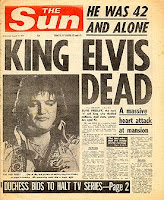 In America, if not much of the western world, the rock star is a symbol of success. Television programs are dedicated to showing the rock star’s lavish, extravagant home—his living room, his kitchen, his swimming pool, his backyard, his stables, and so on. One is presumably interested in the rock star’s special kind of conspicuous consumption--his expensive collection of automobiles, his many motorcycles, his woefully expensive hobbies--because these objects all exemplify various types of material acquisition, an external token of success. Perhaps it is time to devote a collection of rock songs to the life of the rock star, a collection of songs to be sold as a single compact disc, to be titled, perhaps, Life in the Pleasure Dome. The cover image might consist of a picture of Elvis taken in the last six months of his life.
In America, if not much of the western world, the rock star is a symbol of success. Television programs are dedicated to showing the rock star’s lavish, extravagant home—his living room, his kitchen, his swimming pool, his backyard, his stables, and so on. One is presumably interested in the rock star’s special kind of conspicuous consumption--his expensive collection of automobiles, his many motorcycles, his woefully expensive hobbies--because these objects all exemplify various types of material acquisition, an external token of success. Perhaps it is time to devote a collection of rock songs to the life of the rock star, a collection of songs to be sold as a single compact disc, to be titled, perhaps, Life in the Pleasure Dome. The cover image might consist of a picture of Elvis taken in the last six months of his life.
What is called an opulent lifestyle is in fact the wasteful expenditure of something to honor a particular set of cultural values. In the case of the rock star—actually, all stars, movie, television, and otherwise—the particular cultural values are those of extravagant, wasteful expenditure and material acquisition. The two go hand in hand. Drawing upon the theory of sacrifice as explored in Georges Bataille’s The Accursed Share (1949) and his essay, “The Notion of Expenditure” (1933), Life in the Pleasure Dome will be dedicated to celebrating the fundamental American cultural principle of wasteful expenditure as exemplified by the rock star. In the aforementioned works, Bataille explores what he calls “the principle of loss.” Bataille considers sacrifice as a form of non-productive expenditure rather than of (productive) “limited economy.” A “limited economy” attempts to maintain a zero-sum balance of profit and loss, while in contrast wasteful expenditure consists of “considerable losses.” Examples of unproductive, wasteful expenditure include:
luxury, mourning, war, cults, the construction of sumptuary monuments, games, spectacles, arts, perverse sexual activity (i.e., deflected from genital finality)—all these represent activities which...have no end beyond themselves. (118)
We can consider rock music as one of the “arts” Bataille mentions above. For Bataille these various activities constitute a group “characterized by the fact that in each case the accent is placed on a loss that must be as great as possible in order for that activity to take on its true meaning,” that is, a loss that must be both considerable and extravagant. (118)
Stated in another way: For any cultural activity to have real value, the loss must be maximized—excessive. For example, the value of diamond jewels to their owner is determined by how great is the loss in terms of financial expenditure: the more unreasonable and extravagant the expenditure, the greater the value of the diamond jewels. Bataille writes: “Jewels must not only be beautiful and dazzling (which would make the substitution of imitations possible): one sacrifices a fortune, preferring a diamond necklace; such a sacrifice is necessary for the constitution of this necklace’s fascinating character” (“Expenditure” 119). The same principle justifies the inevitable continuation of warfare: as losses, i.e., deaths and maimings, increase, a nation’s stake in a war escalates. As the deaths remorselessly accumulate, the easier it becomes to justify the war’s continuation because the stakes have grown higher. By the continuation of the war, the nation consequently becomes increasingly indebted to those who have died and have been severely maimed in battle; the acknowledgment of this mounting debt ensures that the soldiers’ sacrifices are not in vain, or have become a form of unproductive expenditure.
And yet, despite the fact that extravagant, unreasonable wasteful expenditure is an essential activity of American culture—extravagant luxuries premised on over-consumption such as the heating of huge homes and supplying fuel for gas-guzzling SUVs; millions of gallons of water to keep lawns green; sports and spectacles (e.g., “half-time” shows of “Super Bowls”); NASCAR races dedicated to the consumption of vast quantities of expensive fuel; gambling (the emblem of which is Las Vegas, dedicated to the massive consumption of coal for electric lights and slot machines); prostitution; pornography; and especially warfare—the types of wasteful expenditure (of which a just few are listed here) are consistently denied, degraded, or repressed.
The function of the CD collection Life in the Pleasure Dome is to recognize the repressed or degraded categories of loss, to honor an unacknowledged or repressed set of values that are such an essential, defining feature of American life and culture—success as wasteful expenditure, the indulgence in perverse sexual activity, and the appetite for Romantic self-destruction.
The songs can be conveniently grouped under the following thematic headings (an individual song might fit more than one grouping):
Wasteful Expenditure: The life of the rock star is celebrated because the rock star is an emblem of success: fame and fortune. Success requires a life of excessive, wasteful expenditure, of conspicuous over-consumption, one that consists both of unreasonable financial expenditures as well as vast consumption of natural resources.
Self-destruction: The Romantic myth of the self-destructive artist, one who lives a life of excess (primarily of drugs and alcohol), one of chronic dissipation—“It’s better to burn out than it is to rust.”
Failure: Failure is the anti-myth of success. If the star is a symbol of success, the anti-myth is the failed attempt at stardom, hence the reason why the failed rock star, or the fallen and flabby former rock star, is so contemptible to many Americans.
Perverse Sexual Activity: The sexual excess of the sexually fetishized rock star is exemplified by the phenomena of the “groupie,” the courtesan, the sexually available female whose provocative promiscuity must be both celebrated and degraded at the same time.
1. So You Want to be a Rock ‘n’ Roll Star (1966) – The Byrds 2:05
2. Lodi (1969) – Creedence Clearwater Revival 3:11
3. Working Class Hero (1970) – John Lennon 3:51
4. Superstar (1971) – The Carpenters 3:51
5. The Mud Shark (1971) – Frank Zappa and the Mothers 5:22
6. Ladies of the Road (1971) – King Crimson 5:32
7. Rock ‘n’ Roll Suicide (1972) – David Bowie 2:58
8. Star Star (1973) – The Rolling Stones 4:25
9. We’re an American Band (1973) – Grand Funk Railroad 3:26
10. Workin’ for MCA (1974) – Lynyrd Skynyrd 4:47
11. Turn the Page (1975) – Bob Seger and the Silver Bullet Band 5:05
12. Beth (1976) – Kiss 2:45
13. Life’s Been Good (1978) – Joe Walsh 8:57
14. Burnin’ For You (1981) – Blue Oyster Cult 4:30
15. Money For Nothing (1985) – Dire Straits 8:26
16. Rock Star (1994) – Hole 2:41
17. Rockstar (2005) – Nickelback 4:12 (Total time: 76:03)
Consider the above the liner notes for a CD you yourself burn.
Sunday, May 11, 2008
The Twelfth of Never
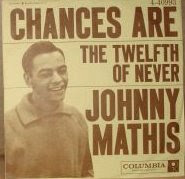 “The Twelfth of Never” is a colloquial expression referring to a hypothetical event that will never happen in the course of one’s lifetime, and one that is unlikely to occur at all. It is also the name of a frequently covered pop song that was a hit in 1957 for Johnny Mathis. Since “The Twelfth of Never” is a love song, the title refers to the moment in time when the singer will ever stop loving his beloved—in other words, never.
“The Twelfth of Never” is a colloquial expression referring to a hypothetical event that will never happen in the course of one’s lifetime, and one that is unlikely to occur at all. It is also the name of a frequently covered pop song that was a hit in 1957 for Johnny Mathis. Since “The Twelfth of Never” is a love song, the title refers to the moment in time when the singer will ever stop loving his beloved—in other words, never.
I’ll love you...Until the twelfth of Never and that’s a long, long time
Since he’ll never stop loving her, he will love her “forever.” Randy Travis sings in the song that became a No. 1 hit, “Forever And Ever, Amen,” “If you wonder how long I’ll be faithful/I’ll be happy to tell you again/I’m gonna love you forever and ever, forever and ever, amen.” As the saying goes, love, like a diamond, lasts forever (amen), except for the skeptic Arthur Lee, who perversely titled Love’s third album Forever Changes (1967), in flat contradiction to the widespread sentiment that love lasts forever, even though he often sang very much like Johnny Mathis on that album.
Thus is my preamble to a blog entry in which I originally set out to discuss songs with numbers in them, prompted by hearing Tommy Tutone’s marvelous “867-5309/Jenny” on the car radio the other day. But I discovered that at least one site has already done something like what I set out to do, so there’s really no need, as the saying goes, to reinvent the wheel. However, lists of songs with numbers in them is one thing; what they mean is, well, a horse of a different color.
There is one particular song with numbers in the title that has always especially interested me—Jimi Hendrix’s “If Six Was Nine,” on Axis: Bold as Love (1967). In 1967, when Hendrix recorded the song, he was writing within a long tradition of pop and rock songs with numbers in them—and a time about ten years after Johnny Mathis recorded “The Twelfth of Never.” Just to get a feel for the subject, I’ve listed some pop songs (including country songs) with numbers in them, in order to reveal the affinity “If Six was Nine” has with songs such as “The Twelfth of Never.” I should add that I’m reasonably confident that all of the following songs appeared before the recording of "If Six was Nine," in October 1967. The list should not be considered exhaustive by any means.
Various numbers: The Night Has a Thousand Eyes, 98.6, 19th Nervous Breakdown, Rainy Day Women #12 & 35, 1941, 18 Yellow Roses, The 59th Street Bridge Song (Feelin’ Groovy)
Highways: Route 66, Highway 61 Revisited, Highway 49
Cars: Rocket 88, 409
Girls: Sixteen Candles, You’re Sixteen, 96 Tears (note: 96=16x6)
Trains: Wreck of the Old 97
12: The Twelfth of Never
10: Ten Little Indians
9: Love Potion No. 9, Apartment No. 9, If Six was Nine
8: Eight Days a Week
7: 7 and 7 Is, 7 O’Clock News/Silent Night
6: Six O’Clock, Six O’Clock in the Morning, If Six was Nine
5: Take Five, Five O’Clock World
4: Positively 4th Street, 4th Time Around
3: Three O’Clock Rock, Wednesday Morning, 3 A.M.
2: Two Faces Have I, Just Out Of Reach (Of My Two Empty Arms), Little Deuce Coupe
1: 1-2-3, Fool #1
0: Love Minus Zero/No Limit
Mickey Newbury’s “33rd of August,” written around the same time as “If Six was Nine” (but probably after, in 1968 or '69), contains the disorientation and dislocation of songs such as “Love Potion No. 9” and “7 & 7 Is” (“I'd sit inside a bottle and pretend that I was in a can”). In these songs, number is associated with external reality, a quotidian grounding in sequential, day-to-day life, the linear world of scientific, instrumental reason. But...that dreary day-to-day reality frequently doesn’t match the internal world of the desirous imagination (or confusion, for that matter), unfettered by quotidian time. Mathematics is a matter of reason, love is a matter of desire; numbers are invoked, but they require a disinterested intellect, in contrast to what is the absolute certainty of feeling. Think of Sam Cooke’s “Wonderful World”:
Don’t know much about geography
Don’t know much trigonometry
Don’t know much about algebra
Don’t know what a slide rule is for
But I do know one and one is two,
And if this one could be with you
What a wonderful world this would be
Hence “The Twelfth of Never” points to a non-event, a moment in sequential, calendrical time that will never happen, a point in time that will never be reached. Just like the “33rd of August,” it refers to an impossible moment in time. In my view, "If Six was Nine” refers to this same impossible moment, a mathematical impossibility, the non-moment in Never when six shall be nine. For me, the song is a declaration of independence. I hear Thoreau in the song, and his statement, "If a man does not keep pace with his companions, perhaps it is because he hears a different drummer. Let him step to the music which he hears, however measured or far away."
If the sun refused to shine
I don’t mind, I don’t mind
If the mountains fell in the sea
Let it be, it ain’t me
Got my own world to live through
And I ain’t gonna copy you
Now if six turned out to be nine
I don’t mind, I don't mind
If all the hippies cut off all their hair
I don’t care, I don’t care. Dig?
‘Cause I’ve got my own world to live through
And I ain't gonna copy you
White collar conservative(s) flashin’ down the street
Pointin’ their plastic finger at me
They’re hopin’ soon my kind will drop and die
But I’m gonna wave my freak flag high. High!
Wave on, wave on
Fall mountains, just don’t fall on me
Go ahead on Mr. Businessman
You can't dress like me
[inaudible talk—see below]
Don’t nobody know what I’m talkin’ about
I’ve got my own life to live
I’m the one that’s got to die
When it’s time for me to die
So let me live my life the way I want to…
There.
Sing on brother, play on drummer
In other words, the day will never come when I'll be like you. So there.
I’ll admit my interpretation doesn’t explore the possible “occult” inferences one can find in the song, as Harry Shapiro and Caesar Glebbeek do in their book Jimi Hendrix: Electric Gypsy (St. Martin’s Griffin, 1995). I suppose my interpretation is fairly banal when compared to theirs; for instance, the reference to "Mr. Businessman" invokes, for me, anyway, the '50s novel The Man in the Gray Flannel Suit (filmed 1956), a code for the ultimate conformist, a person interested only in material acquisition. In contrast, Shapiro and Glebbeek aver that the line, “If the mountains fell in the sea,” refers to the “second world of Hopi creation mythology” (225) because Hendrix was interested in Hopi mythology (or at least read a book about it). They go on to write:
Jimi was interested in the esoteric significance of colours—the ‘vibratory’ power of colour that lies behind expressions such as ‘green with envy,’ ‘seeing red,’ and ‘feeling blue.’ As a lead-in to the last verse . . . Jimi introduces colour symbolism to reinforce the enigmatic nature of his lyrics (‘there ain’t nobody knows what I’m talkin’ about’). He speaks of ‘purple, red, yellow and green’ where (in ancient scripts) purple rays make the individual a self-ruler, red is the colour of the pioneering spirit, green is the ray of balance and harmony achieved through struggle and conflict, while yellow is the colour of creativity. The final occult inference in the song is located in the title itself: in the I Ching commentary, 6 is one of the numbers of Earth, 9 one of the numbers of Heaven.... (225-26).
I’ve never actually heard Hendrix say the four colors that Shapiro and Glebbeek refer (I can’t make out what he is saying, despite the many dozen times I've listened to the song on headphones; I do admit, however, that he is saying something), but I’ll take their word for it. Most certainly colors--in the sense of one's "true colors"--are invoked by his reference to "flag," which carries one's "standard" in a military sense, or identifying colors. "Freak flag," of course, suggests unusual colors, or perhaps even black, as in skin color. And if--as Shapiro and Glebbeek claim--in the I Ching, 6 is indeed one of the numbers of Earth and 9 one of the numbers of Heaven, then the idea of the two places ever possibly being the same names an impossible moment in time--just like "the twelfth of never."
Friday, May 9, 2008
A Horse of a Different Color
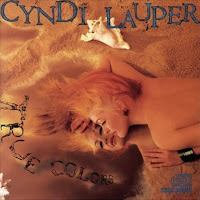 The common meaning of the colloquial expression, “Now, that’s a horse of a different color,” means, “That’s something else,” or “That’s another matter entirely.” For example, if someone says, “I thought that he's her husband but in fact he's her brother—well, now that’s a horse of a different color,” means “the fact that he’s her brother is another matter entirely.” The phrase is commonly believed to have derived from a phrase coined by Shakespeare, who wrote “a horse of that color” (Twelfth Night, Act 2, Scene 3), meaning “the same matter” rather than a different one. Eventually, though, the phrase came to mean difference rather than similarity.
The common meaning of the colloquial expression, “Now, that’s a horse of a different color,” means, “That’s something else,” or “That’s another matter entirely.” For example, if someone says, “I thought that he's her husband but in fact he's her brother—well, now that’s a horse of a different color,” means “the fact that he’s her brother is another matter entirely.” The phrase is commonly believed to have derived from a phrase coined by Shakespeare, who wrote “a horse of that color” (Twelfth Night, Act 2, Scene 3), meaning “the same matter” rather than a different one. Eventually, though, the phrase came to mean difference rather than similarity.
A number of additional colloquialisms have spun off this original expression:
—Stick to your colors, meaning hold on to your view or opinion despite what others may say.
—He’s shown his true colors, meaning his real or true self has been revealed, often used to suggest a person who’s been dissembling in a negative sense.
—He used colorful language, meaning he varied his expression, often employing ribald or raunchy word choice.
—A colorful story, meaning a story told with many lively, engaging, and picturesque details.
—A colorful personality, meaning a person whose personality or behavior is generally interesting to people.
—My view may be colored somewhat, meaning my view may be biased or prejudiced in some particular way.
Many, many popular songs have colors in their titles, but how many use the actual word “color” in their title, and in what sense? Some songs use the word "color" to refer to an actual color or colors, while other meanings of “color” are more elusive, but in general refer to what is “real” or “true,” as in Cyndi Lauper’s “True Colors.” Here are a few songs that use the word color in various ways:
Black is the Color of My True Love’s Hair – Nina Simone
Rose Colored Glasses – John Conlee
Coat of Many Colors – Dolly Parton
Color Me Once – Violent Femmes
She Comes in Colors – Love
Colors – The Oak Ridge Boys
True Colors – Cyndi Lauper
Forbidden Colors – Ryuichi Sakamoto (David Sylvain, vocal; from the soundtrack to Merry Christmas, Mr. Lawrence)
Color My World – Chicago
Colour My World – Petula Clark
The Colour of My Love – Celine Dion
Any Colour You Like – Pink Floyd
Colours – Donovan
Wednesday, May 7, 2008
The Man From Moog
 Donald Cammell and Nic Roeg’s Performance (filmed 1968; released 1970), starring Mick Jagger, James Fox, and Anita Pallenberg, is the first—and so far as I know, only—feature film in which a Moog synthesizer makes an appearance. A synthesizer named TONTO appeared in Brian De Palma’s Phantom of the Paradise (1974) but its sounds were not actually heard in the film.
Donald Cammell and Nic Roeg’s Performance (filmed 1968; released 1970), starring Mick Jagger, James Fox, and Anita Pallenberg, is the first—and so far as I know, only—feature film in which a Moog synthesizer makes an appearance. A synthesizer named TONTO appeared in Brian De Palma’s Phantom of the Paradise (1974) but its sounds were not actually heard in the film.
If records available at moogarchives.com are correct (and there's no reason to believe they are not), then the Rolling Stones did not purchase a Moog synthesizer until 3 September 1968, in other words, about five weeks prior to the end of the filming of Performance, and after the recording of Beggar’s Banquet (and therefore not, as one might have expected, immediately after the recording of 1967’s psychedelic Their Satanic Majesty Requests). And if Trevor Pinch and Frank Trocco, in their marvelous book Analog Days: The Invention and Impact of the Moog Synthesizer (Harvard University Press, 2002) are correct, then Jon Weiss, "the Man from Moog,” did not arrive in London with the Rolling Stones’ Moog synthesizer until late summer 1968, which jibes with the above date of 3 September 1968.
Apparently at the time the idea was that Mick was going to use the Moog synthesizer “as his instrument in the band” (303). At some point, soon after Jon Weiss’s arrival in London, Weiss and Jagger came up with the idea of using the synthesizer as a prop in Performance: “The Moog with its rows of knobs and dials would make a perfect addition” (303). Since, as Pinch and Trocco so astutely observe, the synthesizer was “part of the sixties apparatus for transgression, transcendence, and transformation” (305), the Moog was indeed an ideal prop for Performance, especially since its appearance coincides with Chas’s (James Fox’s) tripping on hallucinogenic mushrooms.
We first see the Moog synthesizer—which would have been an utterly unfamiliar piece of technology to the vast majority of viewers at the time—as it sits on the floor of Turner’s studio, a bewildering array of knobs and patch cables framed by fluorescent light bulbs. Turner sits on the floor before it.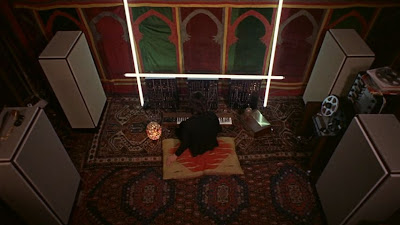
According to Pinch and Trocco, the Moog used in Performance is a Moog Series III modular synthesizer. The above frame grab from the film conveniently shows the three modules characteristic of a "modular synthesizer." Each one of the modules is essentially self-contained; there were virtually no connections within each of the three modules. The purpose of the patch cords, each with a 1/4" phone plug at the end, was to link the modules together; nothing would happen otherwise. The purpose of the patch cords was to carry one of three types of information: signals, or what sound we ultimately would hear; control, a specific (low) voltage telling the modules what to do; and triggers, or electrical pulses, telling the modules what to do at the particular moment.
The special virtue of the Moog was its durability; there was no “right” or “wrong” way to use it—no particular grouping of patches, or combination of knob settings, could damage it. On the other hand, some patch combinations and knob settings would not yield any sound, so while there may have been no right or wrong way to play around with it, if you didn’t know what you were doing, nothing would happen. At the time, therefore, someone who knew how to use it—such as Jon Weiss, "the man from Moog”—was quite valuable.
A closer view shows that a rather simple patch, or connection made between the various modules, has been made. My guess, though, is that while there is the sinister drone characteristic of the Moog on the soundtrack when Chas enters Turner’s studio, that sound was not “live” on the set, but dubbed in later. (The Moog on the soundtrack was played by Bernie Krause, one half of the synthesizer team known as Beaver and Krause.) My guess is that while Mick is shown twiddling some knobs and feigning some adjustments, the synthesizer isn’t actually turned on at all.
What Mick seems to be doing with his left hand is fiddling with the knobs of a controller section, which appears to be a Moog 901A VCO (the "voltage control oscillator," the thin panel at the extreme left) combined with a series of Moog 901B oscillator controllers (each of the panels lined up next to it to the right). His left hand seems to be turning the lower knob of a 901B unit. Directly above his left hand is the 904 series of “filter modules,” the 904A “low pass filter" and the 904B “high pass filter," the electrical systems that in fact defined the Moog and for which Robert Moog had filed patents. The second module from the left, sitting between the 904A (far left) and 904B (right) is the 904C coupler that mixed the output of the two filter modules (it could also be turned off and hence not used). Mick’s head is partially covering the Moog 901 voltage controlled oscillator (VCO), while the larger unit of knobs in the left center of the module on the far right is the Moog 960 sequential controller, which could provide a series of controlled voltages. Only one of the eight stages was active at a time, indicated by the row of lights across the top (none of which are lit, nor does the sequencer appear to be used as a part of the patch).
A better view of the sequential controller can be seen in the following frame grab; other modules in view are various low frequency oscillators, input processors, and a Moog 911 envelope generator. Note that the placement of the patch cords are not the same between the earlier stills and the one below:
The rest of the story:
1) According to Pinch and Trocco (348) the patch that the man from Moog, Jon Weiss, had set up for Mick on the synthesizer used in Performance was used to create the soundtrack for Kenneth Anger’s short film Invocation of My Demon Brother (1969), which featured a soundtrack by Mick Jagger.
2) As is well known, Mick Jagger did not take up the synthesizer—but, according to Pinch and Trocco, the Moog synthesizer originally purchased by the Stones lived on:
It was sold on to the Hansa by the Wall recording studio in Berlin, where in 1973 Christoph Franke of Tangerine Dream purchased it for $15,000. The Moog sequencer became the defining element of Tangerine Dream’s sound, and the Moog became an enduring influence on the many waves of German electronic music in the 1970s. This influence eventually provided renewed stimulus in the United States when Donna Summer’s I Feel Love (1977), produced by Giorgio Moroder in a Munich studio with the aid of a modular Moog, along with Kraftwerk’s Trans-Europe Express (1977), were taken up in black dance culture.... (305-06)
If the Performance modular synth was indeed sold to Christoph Franke of Tangerine Dream in 1973, then the first album made by that group on which that particular Moog appeared was Phaedra, recorded late in 1973 and released early in 1974, an album that is now considered an essential album of electronic music, and a breakthrough in the use of synthesizer/sequencer technology.
Monday, May 5, 2008
The Ballad of John and Yoko's Rolls
 In yesterday's blog I mentioned John Lennon's Rolls-Royce Phantom V, the car that was later repainted in psychedelic fashion (for complete information on this particular Roller, go to the following website). I also said that Lennon didn’t acquire this particular Rolls-Royce until 3 June 1965, and that it was repainted in psychedelic fashion in April 1967. I encourage readers to visit the aforementioned website to verify all of this information.
In yesterday's blog I mentioned John Lennon's Rolls-Royce Phantom V, the car that was later repainted in psychedelic fashion (for complete information on this particular Roller, go to the following website). I also said that Lennon didn’t acquire this particular Rolls-Royce until 3 June 1965, and that it was repainted in psychedelic fashion in April 1967. I encourage readers to visit the aforementioned website to verify all of this information.
I have brought up this issue because a couple of individuals have emailed me--including a third person whom we actually interviewed as part of our research--challenging my and Rebecca's assertion in our book, Donald Cammell: A Life on the Wild Side (2006), that the white Rolls-Royce used at the end of Performance (1970), the one in which Harry Flowers sits awaiting delivery of Chas ("Hello, Chas!"), and the Rolls in which Chas/Turner rides off in the film's final moments, was John Lennon's Phantom V. It was this same white Rolls, so we asserted, that was later used in the Apple Records promotional video, "The Ballad of John and Yoko" (1969). That could not be John Lennon's Rolls-Royce used in the film, we have been informed, because it was painted in psychedelic colors. The Rolls-Royce used at the end of Performance is white. I responded to these queries by saying that we did our research, and that indeed our information is correct.
It is true that three different Rollers were used in Performance: the black one, shown in the film's opening moments; the black Rolls in the garage with a "tasty finish," on which acid is poured, destroying the paint job (actually that Rolls was coated with a clear substance that reacted to the chemicals in the liquid dumped from the jug--that wasn't real acid poured on the Rolls!); and the white Rolls-Royce belonging to John Lennon used in the last sequence.
Since the issue has come up in the past, and since there may be others who haven't written me but who also think we are incorrect, I thought I'd address it, and settle the matter once and for all. I've included below a series of frame grabs from the final moments of Performance in order to fully reveal the identity of the Rolls-Royce used in the last sequence of the film.
The first still consists of a shot taken from Chas/Turner's subjective POV approaching the white Rolls...

Chas/Turner climbs in and the Rolls pulls away, revealing the front license plate, EUC 100C. Note the antenna on the roof toward the front, over the top of the windshield:
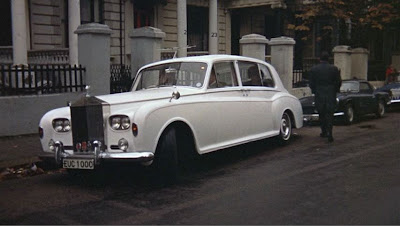
Following the 180 degree rule (editing on the axis), there is a cut to the rear of the Rolls-Royce as it pulls away from the curb and begins down the street. Again the shot reveals the license plate, EUC 100C:
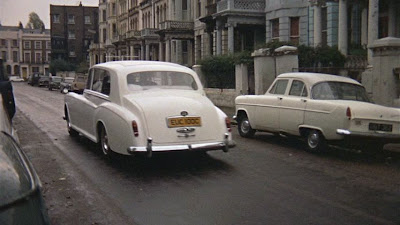
The same white Rolls used in Performance, owned by John Lennon--certainly he was wealthy enough to own more than one such luxury car--was used a few months later in the Apple Records promotional video, "The Ballad of John and Yoko." Please forgive the poor quality of the image, but here's a screen grab taken from early in the video. Note the gull-wing antenna on the roof, near the front windshield:

Here's a shot of the Rolls toward the end of the video (again I apologize for the poor quality of the image). Note the license plate, EUC 100C:

I should also add that David Cammell, the film's Associate Producer, told us that it was John Lennon's car, so I hope that all of this is proof enough that our assertion in our book about the identity of the white Rolls-Royce is correct. The equipment in Turner's "studio" was also borrowed from the Beatles' Abbey Road studio, with the exception of the Moog Series III synthesizer, which was brought over by Jon Weiss, a representative of Moog at the time.
In a subsequent blog I'll discuss what happened to the Moog synthesizer that was used in Performance.
Sunday, May 4, 2008
Moonstruck
 My previous blog entry, “The Sentimental Lunatic,” on the song "Everyone's Gone to the Moon," prompted my friend Tim Lucas to post an interesting comment, which can be found at the end of that blog (portions of it are reproduced below). His response prompted me to reflect on some issues I raised in that blog, which I’d like to expand on, briefly, with this post. For the sake of convenience I’ve reproduced Tim’s response below, splitting it into two parts in order to discuss two distinct issues. I reproduce the first half of his comment here:
My previous blog entry, “The Sentimental Lunatic,” on the song "Everyone's Gone to the Moon," prompted my friend Tim Lucas to post an interesting comment, which can be found at the end of that blog (portions of it are reproduced below). His response prompted me to reflect on some issues I raised in that blog, which I’d like to expand on, briefly, with this post. For the sake of convenience I’ve reproduced Tim’s response below, splitting it into two parts in order to discuss two distinct issues. I reproduce the first half of his comment here:
... My own take on it [“Everyone’s Gone to the Moon”] is quite different, and simpler, than yours. To my thinking, the song sketches a moment in Swinging London’s history when the scene began to darken as harder drugs than marijuana, like cocaine and heroin, came into fashion. Consequently the lyrics are organized to depict various pleasures in contrast with their own cancellation or contradiction, painting a world of plenty that still exists but is beyond the reach of people who are perpetually zonked (e.g., “gone to the moon”), with strength enough only to “lift a spoon.”
His notion that the song is a response or reaction to the darker side of the “Swinging London” scene is very plausible. In my own discussion of the song, I explored the way the song corresponded, in a rather remarkable way, to what Louis A. Sass, in his book Madness and Modernism, calls the schizophrenic Stimmung, or the onset of the radically altered perception of reality that accompanies a schizophrenic break. My own view is that while the song ostensibly offers itself as a quasi-mystical insight into the nature of reality, on closer inspection it is actually closer to an anti-epiphany, an insight into reality that may be true, but one that is terrible or nightmarish rather than positive. I therefore included some image files of paintings by the severely schizoid painter, Giorgio de Chirico, in order to provide a sort of visual equivalent of the perceptual alteration of the world that characterizes the anti-epiphany (supported musically, incidentally, by the song fading out to the discordant sounds of violins being played out of tune).
It seems to me, though, that Tim’s view and my view are not incompatible, just focused differently, his narrowly on the immediate social context in which the song was made, and mine more broadly, on the subjective response to a rapidly changing world of ever-increasing complexity, a response that Alvin Toffler would characterize in the title of a book, published only a few years later, as “future shock”:
Streets full of people all alone
Roads full of houses never home
Church full of singing out of tune
Everyone’s gone to the moon
Eyes full of sorrow never wet
Hands full of money all in debt
Sun coming out in the middle of June
Everyone’s gone to the moon
Long time ago, life had begun
Everyone went to the sun
Cars full of motors painted green
Mouths full of chocolate covered cream
Arms that can only lift a spoon
Everyone’s gone to the moon
My best estimate is that the song was recorded ca. April 1965, thus making it a bit too early to be considered psychedelia, although lyrically speaking it shares features with that form of music. Still, most psychedelia is more benign, more epiphanic, than “Everyone’s Gone to the Moon” (as evidenced by psychedelia’s transformation, as I’ve argued in previous posts on this blog, into bubblegum music). The last set of lyrics, beginning with “Cars full of motors painted green...,” seems especially directed toward a certain “social type” (following Tim’s interpretation), one whose life is composed of affected pretensions and effete mannerisms, and also one of privileged self-indulgence. Indeed, the “Swinging London” of the 60s has been characterized as an unusual mélange of slumming aristocrats and posturing hippies. Along these lines, the aforementioned lyric referring to “Cars...painted green” struck me as a possible oblique reference to John Lennon’s Rolls-Royce Phantom V which Lennon had re-painted in psychedelic colors, but according to this website, Lennon didn’t acquire the Roller until 3 June 1965, and it wasn’t repainted in psychedelic fashion until April 1967—long after “Everyone’s Gone to the Moon” was recorded.
Speaking of historical dating, I’ll return to Tim’s response. Here is most of the second half:
It could even be a criticism of then-fashionable acid rock, given the lines about how “long time ago, life had begun/everyone went to the sun,” which reads to me as an allusion to Brian Wilson, The Beach Boys, and their fun- and life-affirming brand of rock. Indeed, given the fact that The Beach Boys were contemporaneously releasing their masterpiece Pet Sounds, criticized at the time as too downbeat by some, the song could almost be interpreted as a direct criticism of the “moon” music emerging from Brian Wilson's withdrawal into coke and LSD.
Appropriately, Tim brought up a lyric of the song I hadn’t discussed, but allow me to correct him on one factual point before I continue: Pet Sounds wasn’t released until May 1966, almost a year after “Everyone’s Gone to the Moon” had charted in the UK. However, and more importantly, I think he’s correct to associate the reference, “everyone went to the sun,” with American West Coast (“surf”) music such as that played by the Beach Boys, and with California in general. For me, the song that immediately comes to mind in this context, though, and which preceded “Everyone’s Gone to the Moon,” is The Rivieras’ 1964 hit, California Sun. According to this source, “California Sun,” which appeared on the pop charts early in 1964, was one of the last chart-topping songs by an American band on the Billboard Hot 100 chart before the so-called “British Invasion.” And according to another source, "California Sun" would have reached the No. 1 spot on the pop charts if it hadn't been displaced by the Beatles' "I Wanna Hold Your Hand." If this information is correct, then the lyric, “long time ago, life had begun/everyone went to the sun,” can be understood as referring to a time prior to the “British invasion,” the time of the popularization of rock 'n' roll by Elvis (“sun” as in Sun Records, Elvis’s first record label) and American rock ‘n’ rollers such as Buddy Holly, Chuck Berry, The Rivieras, and of course the Beach Boys, displaced by (among others) the Beatles—and even, ironically, “British invasion” songs such as “Everyone’s Gone to the Moon.”
When I set out to discuss "Everyone's Gone to the Moon," I hadn't expected to encounter the richly allusive density of the lyrics. However, thanks to comments such as the one by Tim Lucas, the song is vastly richer than I had ever imagined. Although I frequently curse the amount of time it takes to maintain a blog, it's frequently the case that because I took the time to sit down and write about a particular topic, I end up learning a great deal, much more than I'd imagined, as I did in this case, when writing about the aforementioned song.
Friday, May 2, 2008
The Sentimental Lunatic
 I think Jonathan King’s “Everyone’s Gone to the Moon,” which reached the Top 4 spot in the UK pop charts in late July 1965, is a beautiful song; its aching melancholy has haunted me for decades. I must have been around eleven years old when I first heard it, and I simply can't shake it off. But what is it about? Like a startling image from a strange dream, it remains firmly lodged in my memory, because its strangeness is precisely what makes it so difficult to forget. Many people, I’ve found, have had an odd or unusual dream that they’ve never been able to forget, primarily because they’ve never been able to explain it satisfactorily, if at all.
I think Jonathan King’s “Everyone’s Gone to the Moon,” which reached the Top 4 spot in the UK pop charts in late July 1965, is a beautiful song; its aching melancholy has haunted me for decades. I must have been around eleven years old when I first heard it, and I simply can't shake it off. But what is it about? Like a startling image from a strange dream, it remains firmly lodged in my memory, because its strangeness is precisely what makes it so difficult to forget. Many people, I’ve found, have had an odd or unusual dream that they’ve never been able to forget, primarily because they’ve never been able to explain it satisfactorily, if at all.
And yet, while the song is dream-like by virtue of its apparently stubborn resistance to interpretation, it also gives one the strong impression of being a quasi-mystical insight into the nature of modern life. In addition, its writer seems distinctly modern as well, self-consciously aware of his own mode of awareness, a representative of Schiller’s “sentimental” or “reflective” poet, the kind of writer who is “self-divided because self-conscious, and so composes in an awareness of multiple alternatives, and characteristically represents not the object in itself, but the object in the subject.” (See M. H. Abrams, Natural Supernaturalism, Norton, 1971, pp. 213-14.) In his discussion of literary scholar Joseph Frank’s classic essay, “Spatial Form in Modern Literature” (1945), Louis A. Sass, in his brilliant book, Madness and Modernism (Basic Books, 1992), writes:
...Joseph Frank describes some of the ways modernist fiction attempts to deny its own temporality and approach the condition of the poetic image, defined by Ezra Pound as “that which presents an intellectual and emotional complex in an instant of time.” To achieve this sense of encompassing experiential stasis, writers use a number of devices to draw attention away from both the inherent temporality of language (which by its very nature can only represent one word after another, in a temporal sequence) and the implicit temporality of human action itself, with its purposes and causes. These include: the overwhelming of plot by mythic structures used as organizing devices (as in Joyce’s Ulysses), the movement from perspective to perspective instead of from event to event (for example, Faulkner’s The Sound and the Fury), and the use of metaphoric images as recurring leitmotifs to stitch together separate moments and thereby efface the time elapsed between them (for example, Djuna Barnes’s Nightwood). (34)
At least two of the features of modernist fiction as described above are employed in the lyrics to “Everyone’s Gone to the Moon”: the movement from one subjective perspective to another ("the object in the subject"), and the use of the recurring, metaphorical leitmotiv--the title itself. I reproduce here the lyrics in what I believe to be the accurate form:
Streets full of people all alone
Roads full of houses never home
Church full of singing out of tune
Everyone’s gone to the moon
Eyes full of sorrow never wet
Hands full of money all in debt
Sun coming out in the middle of June
Everyone’s gone to the moon
Long time ago, life had begun
Everyone went to the sun
Cars full of motors painted green
Mouths full of chocolate covered cream
Arms that can only lift a spoon
Everyone’s gone to the moon
It is necessary to go about living in the world, wrote the severely schizoid painter Giorgio de Chirico, “as if in an immense museum of strangeness.” Earlier I described “Everyone’s Gone to the Moon” as suggesting “a quasi-mystical insight,” but perhaps it is more accurately described as an anti-epiphany, which Louis A. Sass defines as, “an experience in which the familiar has turned strange and the unfamiliar familiar, often giving the person the sense of déjà vu and jamais vu, either in quick succession or even simultaneously.” (44) Sass observes that de Chirico took from Nietzsche the untranslatable German word Stimmung to describe the schizophrenic anti-epiphany, which he sees so evocatively captured in de Chirico’s painting Gare Montparnasse (Melancholy of Departure) (1914, pictured above at the top of this entry). “Everyone’s Gone to the Moon” seems very much like the experience of the schizophrenic Stimmung as described by Sass:
Unreality—“a universe of uniform precision and clarity but devoid of the dynamism, emotional resonance, and sense of human purpose that are characteristic of everyday life” (47). In order to illustrate the experience of Unreality, Sass cites the memoir of a schizophrenic named “Renee” to sufficiently capture the disturbing nature of the changed world: “It was...a country, opposed to Reality, where reigned an implacable light, blinding, leaving no place for shadow; an immense space without boundary, limitless, flat; a mineral, lunar country, cold as the wastes of the North Pole” (47).
Roads full of houses never home
Church full of singing out of tune
...
Eyes full of sorrow never wet
Hands full of money all in debt
Renee’s use of “lunar country” is provocative in this context, since the Latin word for “moon” is “luna,” the root of the word “lunatic” (slang: “loonies”), one who is crazy, insane, mad (moonstruck), suffering from “moon madness.” The association of moon and madness is, of course, invoked in Pink Floyd’s “Brain Damage” from Dark Side of the Moon (“The lunatic is on the grass”). Thus we are invited to interpret “everyone’s gone [to the moon]” as “everyone’s gone [mad],” everyone has gone “looney.”
Mere Being—Sass again refers to the memoir of “Renee,” observing: “At other times what astonished Renee...was not so much the absence of a normal sense of authenticity, emotional resonance, or functional meanings, but the very fact that objects existed at all—their Mere Being. Here we encounter an experience so very general in nature, yet at the same time so inherently concrete, so rooted in the mute thereness of the world, as nearly to defy description....such experiences can be akin . . . to the exalting feeling of wonder, mystery, and terror....” (48) (See the de Chirico painting above, Melancholy and Mystery of a Street, 1914.)
Streets, Roads, Church, Eyes, Hands, Sun, Cars...painted green, Mouths, Arms, Motors, Spoon
Fragmentation—“Objects normally perceived as parts of larger complexes may seem strangely isolated, disconnected from each other and devoid of encompassing context; or a single object may lose its perceptual integrity and disintegrate into a disunity of parts.... Another schizophrenic likened his vision of Fragmentation to being ‘surrounded by a multitude of meaningless details.’ ‘I did not see things as a whole,’ he said, ‘I only saw fragments: a few people, a dairy, a dreary house’ (49-50).
Streets full of people all alone
...
Cars full of motors painted green
Mouths full of chocolate covered cream
Arms that can only lift a spoon
Apophany—From the Greek word apophany, meaning “to become manifest.” “Once conventional meanings have faded away (Unreality) and new details or aspects of the world have been thrust into awareness (Fragmentation, Mere Being), there often emerges an inchoate sense of the as yet unarticulated significances of these newly emergent phenomena. In this “mood,” so eerily captured in both the writings and the paintings of de Chirico, the world resonates with a fugitive significance. Every detail and event takes on an excrutiating distinctness, specialness, and peculiarity—some definite meaning that always lies just out of reach, however, where it eludes all attempts to grasp or specify it” (52). In short, every single image implies an elusive “meaning” that lies "just out of reach."
E.g., Arms that can only life a spoon
What is the peculiar specialness, elusiveness, meaning of the utterance, Arms that can only lift a spoon? Decadent, effete behavior? An effect of life in zero-gravity, of living in outer space? The arm of a drug addict (the spoon associated with the intravenous administration of heroin)? Infantile behavior, in the sense that the spoon is the first utensil employed by humans ("spoon-fed")?
Additionally, Sass argues that in modernist art "the post-Kantian awareness of the limitedness of perspective engenders contradictory urges and futile yearnings, cravings to explore unimaginable viewpoints, uninhabitable mental climes," resulting in what he calls a "crossfade technique," in which "two objects or domains [are] so interfused that they seem to have merged, creating a single object that could exist nowhere but in some mental or inner universe...." (137). The entire song works this way, but is exemplified by lyrics such as:
Eyes full of sorrow never wet
Hands full of money all in debt
Sun coming out in the middle of June
Hence "Everyone's Gone to the Moon" might be best understood as a sort of cubist or futurist collage, a heteroclite mélange of "perspectival fluctuations" very similar, as Sass would argue, "to what occurs with schizophrenia" (138).
Wednesday, April 30, 2008
Albert Hofmann, 1906-2008
 Albert Hofmann, the Swiss chemist who devised the technique to make derivatives of lysergic acid and who eventually synthesized lysergic acid diethylamide (LSD), has died of heart failure at the ripe old age of 102.
Albert Hofmann, the Swiss chemist who devised the technique to make derivatives of lysergic acid and who eventually synthesized lysergic acid diethylamide (LSD), has died of heart failure at the ripe old age of 102.
Hofmann was a chemist at the Sandoz Laboratories in Basel, Switzerland, when in the late 1930s he turned to the study of ergot, the name for a fungus that grows on rye, barley and certain other plants. Studying the active ingredient of ergot, a chemical identified by American researchers in the 1930s as lysergic acid, Hofmann invented a method to synthesize a series of compounds of that substance. The 25th one he synthesized was lysergic acid diethylamide, or LSD-25. As is well known, he subsequently, in 1943, became the first person to take an acid trip. LSD-25, Hofmann’s so-called “problem child” as he referred to his creation in his autobiography, subsequently influenced an entire generation, and had a profound influence on the lives of individuals such as Timothy Leary.
Thus Albert Hofmann can be understood as an author, although not necessarily an author of the novelistic sort (he did, though, author numerous scientific articles). In calling Albert Hofmann an author, I have in mind Michel Foucault’s essay, “What Is an Author?,” and his discussion of an uncommon but profound kind of author that Foucault named a “founder of discursivity.” About such authors, Foucault wrote:
They are unique in that they are not just the authors of their own works. They have produced something else: the possibilities and the rules for the formation of other texts. In this sense, they are very different, for example, from a novelist.... Freud is not just the author of The Interpretation of Dreams or Jokes and their Relation to the Unconscious; Marx is not just the author of the Communist Manifesto or Capital: they both have established an endless possibility of discourse.... the initiation of a discursive practice is heterogeneous to its subsequent transformations. To expand a type of discursivity, such as psychoanalysis as founded by Freud, is not to give it a formal generality that it would not have permitted at the outset, but rather to open it up to a certain number of possible applications. (See Josue V. Harari, Textual Strategies, Cornell University Press, 1979, p. 154-56.)
Albert Hofmann was an author of the sort Foucault outlines here: he enabled and initiated the creation of many other texts, in film, literature, art, and perhaps most especially, in music--particularly the form of music that developed in the 1960s, psychedelia. Hence Albert Hofmann can be understood as one of the more significant and influential authors of the twentieth century, and perhaps should be remembered as such.
A compelling obituary can be found here.
Are You Experienced (Enough)?
 Several news articles have appeared on the web this morning claiming that a roughly 11-minute video has been released for sale on the internet that shows the late Jimi Hendrix having sex with two women “in a dimly lit bedroom.”
Several news articles have appeared on the web this morning claiming that a roughly 11-minute video has been released for sale on the internet that shows the late Jimi Hendrix having sex with two women “in a dimly lit bedroom.”
Although the DVD version (and perhaps the version available for download, I don't know) apparently contains the testimony of two former Sixties groupies—one the well-known fellatrix Pamela Des Barres, the other Cynthia Albritton aka “Cynthia Plaster Caster” averring the authenticity of the footage—there is every reason to believe the video is a hoax, as “authentic” as the video purportedly containing footage of an alien autopsy. Whether Jimi Hendrix indulged in the ménage is not the issue here; I’ll leave that for others to fret over (assuming it makes any difference to anyone). However, the reasons for my suspicion that this video is a hoax are as follows:
1. Anecdotal Evidence:
A.) Vivid Entertainment Group (VEG) averred “in a press release” (i.e., a photocopied sheet of paper, not a sworn affidavit) that they consulted with many “experts.” Experts on what? The anatomy of Jimi Hendrix? (Are there such experts?) The period authenticity of the putative source materials, the alleged film footage—it was the pre-video time period, remember, when the footage was shot? The décor, meaning they can ascertain whether the location was Britain or America by means of furniture, wall fixtures, etc.? The aforementioned former groupies are among the so-called experts. VEG’s claim is that the former groupies, more so than anyone, ought to recognize the genitals of someone with whom they were intimate, even if that intimacy (of whatever sort) was forty years ago. After all, claims VEG, their chosen area of expertise was male genitalia.
B.) Vague, questionable provenance: Some news articles refer to a “tape,” although again if the event recorded actually took place forty years ago, it is highly unlikely that the footage was shot on video, but more likely film (one article I read did in fact refer to “8mm footage”). VEG purchased the “tape” from an individual named Howie Klein, who brought the “tape” to Vivid after he, Klein, acquired it from a collector “who found it.” How and where was it found? Where has the footage been stored for the past forty years, and how was it discovered? Who is the unidentified “rock and roll memorabilia collector” referred to in some news articles, and how did he (or she) acquire it? What was the method by which Mr. Klein authenticated the “tape”--or film--prior to purchasing it? Who is the cameraman who claims to have shot the footage? Why and under what particular circumstances was he hired (or designated) to do so? If the material object in question were a painting rather than very easily faked video footage, would its authenticity be unquestionably guaranteed by such a dubious provenance?
C.) The location of the ménage, “a dimly lit bedroom,” smacks of the “unidentified location” where, for instance, the alien autopsy took place. Moreover, the fact that the bedroom is "dimly lit" is suspicious, as it makes the identity of the individuals in the scene more difficult to determine. VEG claims the footage is forty years old, but unless the 8mm footage can be produced and can be subject to the same intense scrutiny as the Zapruder footage of the Kennedy assassination, VEG's claim has the same truth value as an opinion of belief.
D.) VEG lawyers allegedly hired “private investigators” to track down the man who claims to have been the cinematographer of the event. Even if this is true, it doesn’t “authenticate” the footage. There have been individuals over the years swearing to have seen dead alien bodies after the supposed Roswell UFO crash. Neither lawyers nor private investigators have access to the private contents of a person’s mind; all they can do is verify the actual identity of the person making the claim, and verify that this person, so identified, swears (believes) he or she is telling the truth about the matter. An individual may swear he or she is telling the truth about seeing the body of a dead alien, but this does not prove whatsoever the existence of the alien body. As many studies of perceptual cognition have revealed, what one sees isn't simply a matter of sensory apparatus (the eyes), but what thinks one sees (think of the famous example of the "duck-rabbit"). Perceptual ambiguity is precisely the issue here: who is that person in the footage?
2. Counter-Evidence:
A.) Kathy Etchingham, Jimi Hendrix’s long-time girlfriend, after viewing several still photographs of the footage, has told several newspapers, “It is not him.” Doesn’t she qualify as an expert?
B.) Charles R. Cross, author of the excellent Hendrix biography Room Full of Mirrors, who saw the footage while he was researching his book and dismissed it at the time as fake, also disputes the identity of the man in the "tape," claiming among other things that Hendrix was too painfully shy to have agreed to perform sexual acts on camera. Like Kathy Etchingham, he also claims the person is not Hendrix. Doesn’t he qualify as an expert? The fact that Mr. Cross saw the footage while researching his biography means the existence of the footage has been known for, at the very least, four years (the hardcover edition of his biography was published in 2005), and perhaps longer, but no one took it seriously.
C.) At the time (ca. 1968), most enthusiasts purchased unexposed negative for 8mm cameras in the form of cartridges containing a film spool three minutes in length. While it is possible the alleged footage could have been shot using several such cartridges, the color film in each cartridge, unless the conditions were extremely well-controlled, often would often develop with minor differences in contrast levels and color saturation. I haven’t seen the footage of the menage, but if it consists of one uninterrupted eleven-minute sequence, it’s likely faked. However, someone trying to pull off a clever hoax, knowing how amateurs purchased 8mm film stock at the time, might well have used computer technology to imitate different color and contrast levels in roughly three-minute segments.
3. Legal Status of the Footage:
A spokesman for Experience Hendrix, the Seattle company owned by Hendrix’s relatives that controls the rights to his music, said, “We’re in no position to verify [the tape’s authenticity],” meaning his company doesn’t claim to have anyone on staff with the competency (expertise) to very the authenticity of the footage--in contrast, to, say, VEG--meaning the company isn't saying one way or the other. The company's denial of expertise thus enables VEG legally to distribute the footage because as far as VEG is concerned, the person being filmed doesn’t have to be really Hendrix anyway, but merely a person possessing “Hendrix’s likeness.” Surprisingly, it seems that the rights to Hendrix’s likeness remains an unsettled legal issue--the loophole necessary to have enabled VEG to distribute the video.
Monday, April 28, 2008
The Reassurance of Fratricide
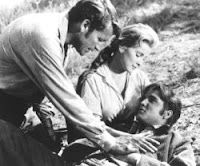 The title of my entry is taken from Benedict Anderson’s book, Imagined Communities (Revised Edition, Verso, 1991), and his discussion of memory and forgetting, that is, the way the writing of history constitutes an act that consists both of remembering (anamnesis) and its opposite, amnesia. Since history is written by the victors, the Civil War, for example, is consequently the enactment of the hostility of “brother against brother,” that is, the story of Cain and Abel (hence the inspiration for his homiletic parody, "the reassurance of patricide"). Had the Confederacy won, however, it might well have been about something, speculates Anderson, "quite unbrotherly" (201).
The title of my entry is taken from Benedict Anderson’s book, Imagined Communities (Revised Edition, Verso, 1991), and his discussion of memory and forgetting, that is, the way the writing of history constitutes an act that consists both of remembering (anamnesis) and its opposite, amnesia. Since history is written by the victors, the Civil War, for example, is consequently the enactment of the hostility of “brother against brother,” that is, the story of Cain and Abel (hence the inspiration for his homiletic parody, "the reassurance of patricide"). Had the Confederacy won, however, it might well have been about something, speculates Anderson, "quite unbrotherly" (201).
Fratricide: the story of brother against brother, the mythic archetype of Cain and Abel. Elvis Costello wrote “Blame it on Cain,” but I choose to blame it on Elvis, primarily for the act of fratricide that drives the plot of his first movie, Love Me Tender (1956). In his first film role, Elvis played Clint Reno, who during the Civil War remained home while his older brother, Vance (Richard Egan), fought on the side of the Confederacy. At war’s end, Vance returns home to discover that during his absence his former beloved, Cathy (Debra Paget), has married his brother Clint. But...there is an alibi, or excuse, for this state of affairs, because Clint and Cathy had been told that Vance had been killed in battle. Predictably, as one might expect, the story moves inexorably toward its tragic conclusion, foregrounded as it is by brotherly strife.
Since Elvis, or perhaps because of Elvis, there have been many songs reenacting, in various guises, the story of Cain and Abel. Here are a few representative recordings:
The Boomtown Rats, "I Don't Like Mondays"
The Buggles, “Video Killed the Radio Star”
Johnny Cash, “Frankie and Johnny” & “Folsom Prison Blues”
The Doors, “The End” (parricide) & “Riders on the Storm”
The Eagles, “Doolin-Dalton”
Lefty Frizzell, “Long Black Veil”
Lorne Greene, "Ringo"
Jimi Hendrix, “Hey Joe”
Robert Johnson, "32-20 Blues"
The Kingston Trio, “Tom Dooley”
Vicki Lawrence, “The Night the Lights Went Out in Georgia”
The Louvin Brothers, “Knoxville Girl”
Bob Marley, “I Shot the Sheriff”
Crispian St. Peters, “The Pied Piper”
Pink Floyd, "Careful With That Axe, Eugene"
Gene Pitney, "The Man Who Shot Liberty Valance"
Stan Ridgway, “Peg and Pete and Me” & "Down the Coast Highway"
Marty Robbins, “El Paso" & "Big Iron"
Jimmy Lee Robinson, “I Shot a Man”
Kenny Rogers and the First Edition, “Ruby, Don’t Take Your Love to Town”
The Rolling Stones, “Midnight Rambler”
Bruce Springsteen, “Nebraska”
Hank Snow, “Miller’s Cave”
Suicidal Tendencies, “I Shot the Devil”
Talking Heads, “Psycho Killer”
Hank Williams, Jr., “I’ve Got Rights”
Neil Young, “Down by the River” & “Southern Man”


